
The Tortricidae are a family of moths, commonly known as tortrix moths or leafroller moths, in the order Lepidoptera. This large family has over 11,000 species described, and is the sole member of the superfamily Tortricoidea, although the genus Heliocosma is sometimes placed within this superfamily. Many of these are economically important pests. Olethreutidae is a junior synonym. The typical resting posture is with the wings folded back, producing a rather rounded profile.

Frass refers loosely to the more or less solid excreta of insects, and to certain other related matter.

Cleridae are a family of beetles of the superfamily Cleroidea. They are commonly known as checkered beetles. The family Cleridae has a worldwide distribution, and a variety of habitats and feeding preferences.
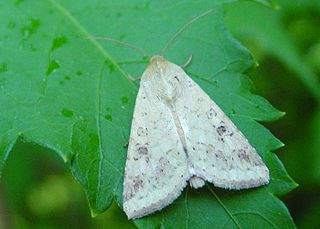
Helicoverpa armigera is a species of Lepidoptera in the family Noctuidae. It is known as the cotton bollworm, corn earworm, Old World (African) bollworm, or scarce bordered straw. The larvae feed on a wide range of plants, including many important cultivated crops. It is a major pest in cotton and one of the most polyphagous and cosmopolitan pest species. It should not be confused with the similarly named larva of the related species Helicoverpa zea.
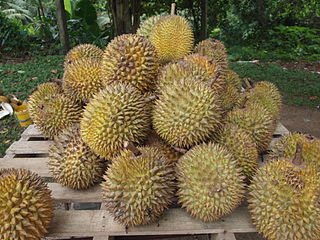
The durian is the edible fruit of several tree species belonging to the genus Durio. There are 30 recognized Durio species, at least nine of which produce edible fruit. Durio zibethinus, native to Borneo and Sumatra, is the only species available on the international market. It has over 300 named varieties in Thailand and 100 in Malaysia as of 1987. Other species are sold in their local regions.

Cryptophlebia ombrodelta, the litchi fruit moth or macadamia nut borer, is a moth of the family Tortricidae. The species was first described by Oswald Bertram Lower in 1898. It is native to India, Sri Lanka, Nepal, Indonesia, China, Taiwan, Vietnam, Thailand, western Malaysia, New Guinea, the Philippines, Japan, Guam, the Caroline Islands, Australia and has been introduced to Hawaii.

Penicillaria jocosatrix, the mango shoot borer, is a moth of the family Euteliidae first described by Achille Guenée in 1852. It is found from southeast Asia to the Pacific. Records include Borneo, Guam, Hawaii, India, Sri Lanka, Thailand and in Australia, Western Australia, the Northern Territory and Queensland.
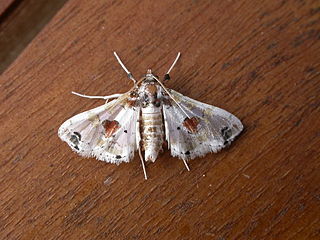
Leucinodes orbonalis, the eggplant fruit and shoot borer or brinjal fruit and shoot borer, is a moth species in the genus Leucinodes described by Achille Guenée in 1854. Its native distribution is in the tropical and subtropical parts of Australia and Asia, where it is recorded from Pakistan, Nepal, India, including the Andaman Islands, Sri Lanka, Bangladesh, Myanmar, Laos, Cambodia, Vietnam, Thailand, China, Taiwan, Japan, Malaysia, Singapore, Brunei, the Philippines, and Indonesia (Java). It has also been intercepted from fruit imports in the U.S.A., the Netherlands, Denmark and Great Britain, where it was also reported from the wild. A taxonomic revision of the Leucinodes species of Sub-Saharan Africa concluded that L. orbonalis is currently not present in Africa, and that previous records of this species were misidentifications of previously undescribed species.
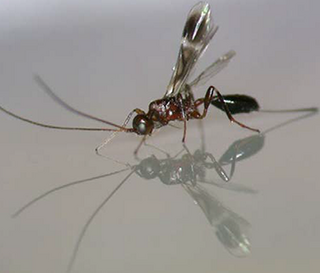
Spathius agrili is a parasitic non-stinging wasp of family Braconidae which is native to North Asia. It is a parasitoid of the emerald ash borer, an invasive species which has destroyed tens of millions of ash trees in its introduced range in North America. As part of the campaign against the emerald ash borer (EAB), American scientists in conjunction with the Chinese Academy of Forestry began searching in 2003 for its natural enemies in the wild, leading to the discovery of several parasitoid wasp species, including Spathius agrili. S. agrili was discovered in Tianjin, China where it is a prevalent parasitoid of EAB larvae in stands of an introduced ash species, and an endemic ash species. S. agrili has been recorded to attack and kill up to 90 percent of EAB larvae.
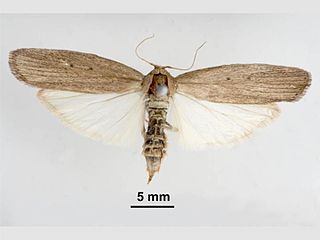
Eldana is a genus of moths of the family Pyralidae containing only one species, the African sugar-cane borer, which is commonly found in Equatorial Guinea, Ghana, Mozambique, Sierra Leone and South Africa. Adults have pale brown forewings with two small spots in the centre and light brown hindwings, and they have a wingspan of 35mm. This species is particularly relevant to humans because the larvae are a pest of the Saccharum species as well as several grain crops such as sorghum and maize. Other recorded host plants are cassava, rice and Cyperus species. When attacking these crops, E. saccharina bores into the stems of their host plant, causing severe damage to the crop. This behavior is the origin of the E. saccharrina's common name, the African sugar-cane borer. The African sugar-cane borer is a resilient pest, as it can survive crop burnings. Other methods such as intercropping and parasitic wasps have been employed to prevent further damage to crops.
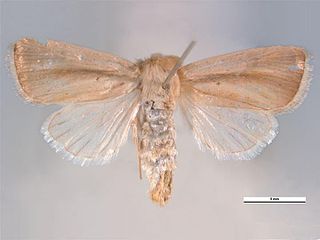
Sesamia inferens, the Asiatic pink stem borer, gramineous stem borer, pink borer, pink rice borer, pink rice stem borer, pink stem borer, purple borer, purple stem borer or purplish stem borer, is a moth of the family Noctuidae. The species was first described by Francis Walker in 1856. It is found from Pakistan, India, Sri Lanka, Myanmar to Japan and the Solomon Islands. A polyphagous species, it is a major pest in many crops worldwide.

Scirpophaga incertulas, the yellow stem borer or rice yellow stem borer, is a species of moth of the family Crambidae. It was described by Francis Walker in 1863. It is found in Afghanistan, Nepal, north-eastern India, Sri Lanka, Bangladesh, Myanmar, Vietnam, Thailand, Malaysia, Singapore, Sumatra, Java, Borneo, Sumba, Sulawesi, the Philippines, Taiwan, China and Japan.
Fundella pellucens, the Caribbean pod borer, is a species of snout moth in the genus Fundella. It was described by Zeller in 1848.

Ostrinia furnacalis is a species of moth in the family Crambidae, the grass moths. It was described by Achille Guenée in 1854 and is known by the common name Asian corn borer since this species is found in Asia and feeds mainly on corn crop. The moth is found from China to Australia, including in Java, Sulawesi, the Philippines, Borneo, New Guinea, the Solomon Islands, and Micronesia. The Asian corn borer is part of the species complex, Ostrinia, in which members are difficult to distinguish based on appearance. Other Ostrinia such as O. orientalis, O. scapulalis, O. zealis, and O. zaguliaevi can occur with O. furnacalis, and the taxa can be hard to tell apart.

Xylosandrus compactus is a species of ambrosia beetle. Common names for this beetle include black twig borer, black coffee borer, black coffee twig borer and tea stem borer. The adult beetle is dark brown or black and inconspicuous; it bores into a twig of a host plant and lays its eggs, and the larvae create further tunnels through the plant tissues. These beetles are agricultural pests that damage the shoots of such crops as coffee, tea, cocoa and avocado.
Nealiolus curculionis is a species of parasitic wasp in the family Braconidae. It is a parasitoid of the sunflower stem weevil Cylindrocopturus adspersus, and a number of other species of stem-boring weevils.

K. Kunhikannan was a pioneer agricultural entomologist and the first Indian to serve as an entomologist in the state of Mysore. Aside from entomology related publications, he wrote two books The West (1927) and A Civilisation at Bay. He was a friend and admirer of the humanist Brajendra Nath Seal and the British writer Lionel Curtis who sought a single united world government. As an agricultural entomologist, he identified several low-cost techniques to pest management and was a pioneer of classical biological control approaches in India.

Oemona hirta, the lemon tree borer, also known as the whistling beetle or the singing beetle, is a longhorn beetle endemic to New Zealand. Its larvae are generalist feeders, boring into the wood of a wide variety of trees, native and introduced. When citrus orchards were first established in New Zealand, this beetle started inflicting serious damage, and so gained the name "lemon tree borer". Four species within the genus Oemona have been identified, suggesting that more species could be found. When disturbed by predators or humans, the adult beetle stridulates creating a "rasp" or "squeak" sound by rubbing its thorax and head together against an area of thin ridges. Māori would eat a liquid called "pia manuka", which was produced by manuka trees when its wood was damaged by the larvae. When Captain Cook first arrived in NZ, his naturalists, Banks and Solander, collected a lemon tree borer in their first collection between 1769 and 1771. This oldest collected specimen can be found in the British Museum. A few years after the first collection, the species would be first described by the Danish naturalist Fabricius in 1775.

Odoiporus longicollis, commonly known as banana stem weevil or banana pseudostem borer, is a species of weevil found in South Asia and South East Asia.





















